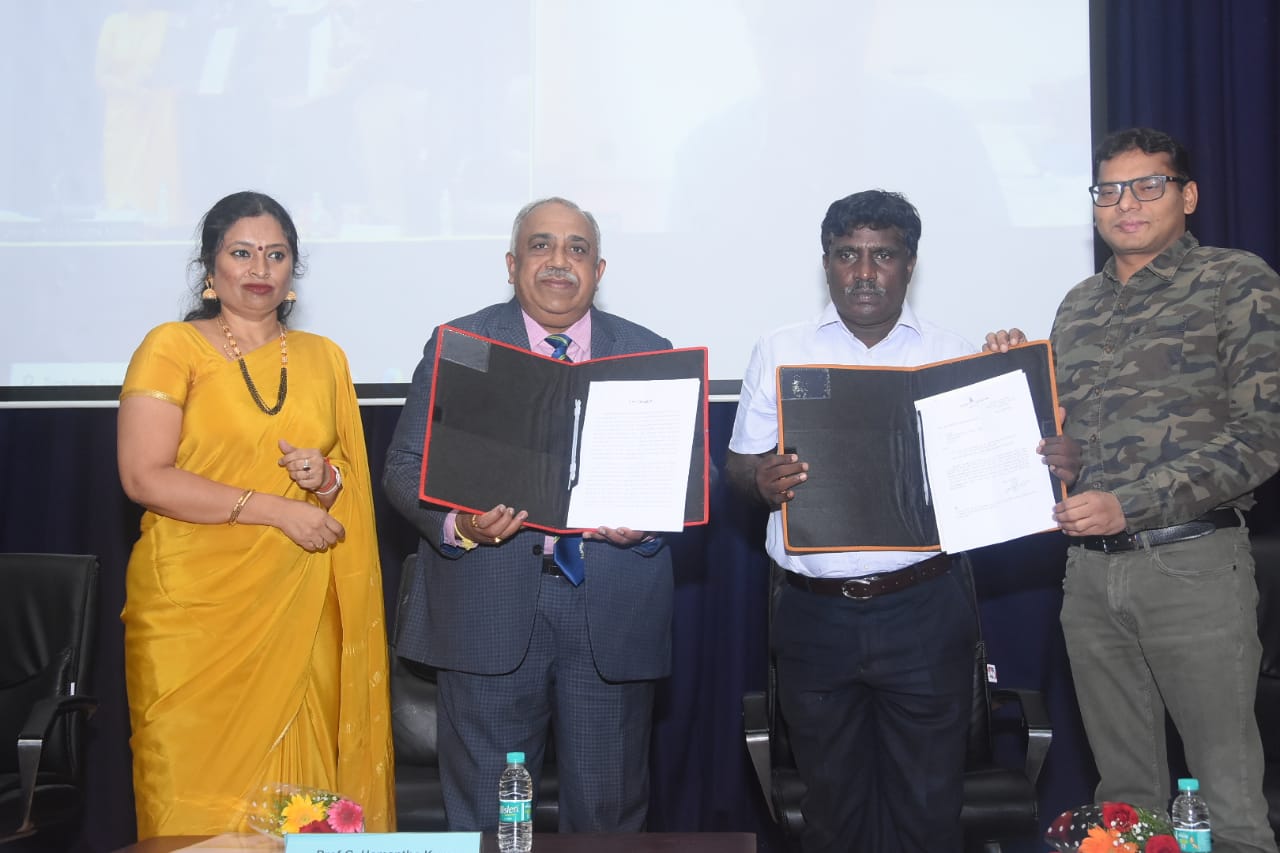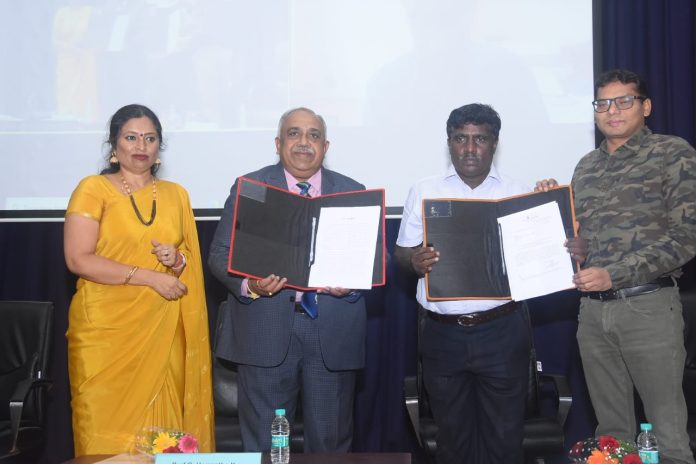ಮೈಸೂರು, ಮೇ 12, 2022 : ಮೈಸೂರು ವಿಶ್ವವಿದ್ಯಾನಿಲಯದ ಜೆನೆಟಿಕ್ಸ್ ಮತ್ತು ಜಿನೋಮಿಕ್ಸ್ ಅಧ್ಯಯನ ವಿಭಾಗವು ಕರ್ನಾಟಕ ಅರಣ್ಯ ಇಲಾಖೆಯೊಂದಿಗೆ ‘ಡಿಎನ್ಎ ಪ್ರೊಫೈಲಿಂಗ್’ ತಂತ್ರಗಳನ್ನು ಬಳಸಿಕೊಂಡು ರಾಮದೇವರ ಬೆಟ್ಟ ರಾಮನಗರದಲ್ಲಿ ರಣಹದ್ದು ಸಂರಕ್ಷಣಾ ಧಾಮದಲ್ಲಿ ವೈಜ್ಞಾನಿಕ ಅಧ್ಯಯನ ಮತ್ತು ಸಂಶೋಧನೆ ಎಂಬ ಪ್ರತಿಷ್ಠಿತ ಯೋಜನೆಗೆ ಮಾನಸ ಗಂಗೋತ್ರಿ ವಿಜ್ಞಾನ ಭವನದಲ್ಲಿ ಗುರುವಾರ ಒಡಂಬಡಿಕೆ ಮಾಡಿಕೊಳ್ಳಲಾಯಿತು.
ಮೈವಿವಿ ಕುಲಪತಿ ಪ್ರೊ. ಜಿ.ಹೇಮಂತ್ ಕುಮಾರ್, ಡಿಸಿಎಫ್ ಗಳಾದ ಏಡುಕುಂಡಲು, ವಿ.ದೇವರಾಜ್ ಹಾಗೂ ಈ ಯೋಜನೆಯ ಪ್ರಧಾನ ಸಂಯೋಜಕರು ಪ್ರೊ.ಎಸ್.ಎಸ್.ಮಾಲಿನಿ ಒಡಂಬಡಿಕೆ ಕಾರ್ಯಕ್ರಮದಲ್ಲಿ ಹಾಜರಿದ್ದರು. ಅಳಿವಿನಂಚಿನಲ್ಲಿರುವ ರಣಹದ್ದುಗಳ ರಕ್ಷಣೆ ಹಾಗೂ ಉಳಿವಿಗಾಗಿ ಆಧುನಿಕ ತಂತ್ರಜ್ಞಾನ ಬಳಸಿ ಅವುಗಳ ಸಂತತಿ ಹೆಚ್ಚು ಮಾಡುವುದು ಈ ಯೋಜನೆ ಮುಖ್ಯ ಉದ್ದೇಶವಾಗಿದೆ.

ವಿವಿ ಕುಲಪತಿ ಪ್ರೊ.ಜಿ.ಹೇಮಂತ್ ಕುಮಾರ್ ಮಾತನಾಡಿ, ಇದೊಂದು ಐತಿಹಾಸಿಕ ಒಪ್ಪಂದ. ವಿವಿ ಜೆನೆಟಿಕ್ಸ್ ವಿಭಾಗವು ಅರಣ್ಯ ಇಲಾಖೆಯೊಂದಿಗೆ ಮಹತ್ತರ ಅಧ್ಯಯನ ಯೋಗ್ಯ ಒಪ್ಪಂದಕ್ಕೆ ಇಂದು ಸಹಿ ಹಾಕಿದೆ. ಇದು ಜೀವ ವೈವಿಧ್ಯತೆ ಹಾಗೂ ಆಹಾರ ಸರಪಳಿ ರಚನೆ ವಿಷಯದಲ್ಲಿ ಪ್ರಮುಖ ಪಾತ್ರ ವಹಿಸಲಿದೆ. ಇಂದು ರಣಹದ್ದುಗಳ ಸಂಖ್ಯೆ ಕಡಿಮೆ ಆಗುತ್ತಿದೆ. ಯಾವುದೇ ಪ್ರಾಣಿ ಉಳಿವು ವಂಶವಾಹಿಯನ್ನು ಅವಲಂಬಿಸಿರುತ್ತದೆ. ಈ ಒಪ್ಪಂದದ ಮೂಲಕ ಅರಣ್ಯ ಇಲಾಖೆಯೊಂದಿಗೆ ಸೇರಿ ರಣಹದ್ದುಗಳ ‘ಡಿಎನ್ಎ ಪ್ರೋಪೈಲಿಂಗ್’ ಮಾಡಲು ವಿವಿ ನಿರ್ಧರಿಸಿದೆ. ಅಲ್ಲದೆ, ರಣಹದ್ದುಗಳಲ್ಲಿ ಯಾವುದು ಗಂಡು, ಯಾವುದು ಹೆಣ್ಣು ಎಂದು ಗುರುತಿಸುವುದು ಕಷ್ಟ. ಈ ಡಿಎನ್ಎ ಟೆಸ್ಟ್ ಮೂಲಕ ರಣಹದ್ದುಗಳ ಲಿಂಗವನ್ನು ಬೇಗ ಪತ್ತೆಹಚ್ಚಬಹುದು. ಇದು ರಣಹದ್ದು ಸಂತತಿ ಹೆಚ್ಚು ಮಾಡಲು ಸಹಕಾರಿಯೂ ಆಗಲಿದೆ ಎಂದರು
ರಣಹದ್ದು ಸಂರಕ್ಷಣಾ ಕಾರ್ಯಕ್ರಮದ ನಿರ್ದೇಶಕರಾದ ವಿಧು ಪ್ರಕಾಶ್ ಮಾತನಾಡಿ, ಮೂರು ವಿಧದ ರಣಹದ್ದು ಅವಸಾನದ ಅಂಚಿನಲ್ಲಿದೆ. ಉದ್ದ ಕೊಕ್ಕಿನ ರಣಹದ್ದು , ತೆಳು ಕೊಕ್ಕಿನ ರಣಹದ್ದು ಹಾಗೂ ಬಿಳಿಬೆನ್ನಿನ ರಣಹದ್ದು ಸದ್ಯ ಅಳಿವಿನಂಚಿನಲ್ಲಿರುವ ಪ್ರಭೇದಗಳು.ಸತ್ತ ದೇಹವನ್ನು ತಿನ್ನುತ್ತವೆ. ಆಹಾರ ಹುಡುಕಿಕೊಂಡು 100 ಕಿಮೀ ವರೆಗೆ ಹಾರಾಟ ನಡೆಸುತ್ತವೆ. 1980 ರಲ್ಲಿ ಭಾರತದಲ್ಲಿ 40 ಮಿಲಿಯನ್ ಇದ್ದ ರಣಹದ್ದುಗಳು ಸಂಖ್ಯೆ ಇದೀಗ ಗಣನೀಯವಾಗಿ ಕಡಿಮೆ ಆಗಿದೆ ಎಂದು ಹೇಳಿದರು.
ಮಲೆಮಹದೇಶ್ವರ ಬೆಟ್ಟ ವನ್ಯಧಾಮದ ಡಿಸಿಎಫ್ ಏಡುಕೊಂಡಲು ಮಾತನಾಡಿ, ಆಹಾರ ಸರಪಳಿಯಲ್ಲಿ ನಿರ್ಣಾಯಕ ಪಾತ್ರ ವಹಿಸಿರುವ ರಣಹದ್ದುಗಳ ಸಂಖ್ಯೆ ಇತ್ತೀಚಿನ ದಿನಗಳಲ್ಲಿ ಶೇ.95ರಷ್ಟು ಇಳಿಕೆಯಾಗಿದೆ. ಭಾರತದಲ್ಲಿ 9 ಜಾತಿಯ ರಣಹದ್ದುಗಳು ಇದ್ದು , ಇದೀಗ ಕೇವಲ 3 ಜಾತಿಯ ರಣಹದ್ದುಗಳು ಮಾತ್ರ ಉಳಿದುಕೊಂಡಿವೆ. ಈ ಮೂರು ತಳಿಗಳ ಜೀವನ ವಿಧಾನ, ದೇಹ ರಚನೆ, ವಂಶವಾಹಿ ಬಗ್ಗೆ ಅಧ್ಯಯನ ನಡೆಸಿದರೆ ರಣಹದ್ದುಗಳ ಸಂತಾನೋತ್ಪತಿಯನ್ನು ಹೆಚ್ಚು ಮಾಡಬಹುದು ಎಂದರು.

ರಾಮನಗರ ಡಿಸಿಎಫ್ ವಿ.ದೇವರಾಜ್ ಮಾತನಾಡಿ, ರಾಮದೇವರ ಬೆಟ್ಟದಲ್ಲಿ ಅಳಿವಿನಂಚಿನಲ್ಲಿರುವ ಕನಿಷ್ಠ 5 ಉದ್ದ ಕೊಕ್ಕಿನ ರಣಹದ್ದು ಇದೆ. ಇತ್ತೀಚಿಗೆ ಒಂದು ಮರಿಯನ್ನೂ ಹಾಕಿದೆ. ಈ ಭಾಗದಲ್ಲಿ ರಣಹದ್ದುಗಳ ಸಂಖ್ಯೆ ಎಷ್ಟಿರಬಹುದು? ಅವುಗಳ ಆರೋಗ್ಯ ವೃದ್ಧಿಗೆ ಏನು ಮಾಡಬಹುದು ಎಂಬುದನ್ನು ಅಧ್ಯಯನ ನಡೆಸುವುದೇ ಡಿಎನ್ಎ ಟೆಸ್ಟ್ ಯೋಜನೆ ಉದ್ದೇಶ ಎಂದರು.
ಯೋಜನೆ ಪ್ರಧಾನ ಸಂಯೋಜಕಿ ಪ್ರೊ.ಎಸ್.ಎಸ್.ಮಾಲಿನಿ, ಮಾತನಾಡಿ, ಯಾವುದೇ ಪ್ರಾಣಿ ಸತ್ತಾಗ ಅದನ್ನು ರಣಹದ್ದು ತಿನ್ನುತ್ತಿತ್ತು. ಇದರಿಂದ ಸತ್ತ ಪ್ರಾಣಿಯಲ್ಲಿದ್ದ ವೈರಸ್ ಅಥವಾ ಬ್ಯಾಕ್ಟೀರಿಯಾ ರಣಹದ್ದು ಹೊಟ್ಟೆಯೊಳಗೆ ಸತ್ತು ಹೋಗುತ್ತಿತ್ತು. ಆ ಜೀರ್ಣಶಕ್ತಿಯೂ ರಣಹದ್ದಿಗೆ ಇತ್ತು . ಆದರೆ, ಈಗ ರಣಹದ್ದುಗಳು ಅಳಿವಿನಂಚಿನಲ್ಲಿರುವುದರಿಂದ ಸತ್ತ ಪ್ರಾಣಿಗಳನ್ನು ತಿನ್ನುತ್ತಿರುವ ನಾಯಿ, ಕಾಗೆ, ಕೋಳಿಗಳಿಂದ ವೈರಸ್ ಹರಡುತ್ತಿದೆ. ಇದು ಅಪಾಯಕಾರಿ ಬೆಳವಣಿಗೆ. ರಣಹದ್ದುಗಳ ಸಂರಕ್ಷಣೆಯಷ್ಟೇ ಇದಕ್ಕಿರುವ ಪರಿಹಾರ. ಹಾಗಾಗಿ ರಣಹದ್ದುಗಳ ಸಂತಾನೋತ್ಪತಿ ಹೆಚ್ಚಿಸಲು ಡಿಎನ್ಎ ಪ್ರೋಪೈಲಿಂಗ್ ಮಾಡಲಾಗುತ್ತಿದೆ ಎಂದರು.
ಪ್ರೊ.ರಾಮಚಂದ್ರ , ಪ್ರೊ.ಮೇವಾಸಿಂಗ್, ಪ್ರೊ. ಅಮೃತವಲ್ಲಿ ಸೇರಿದಂತೆ ಇತರರು ಇದ್ದರು.

key words : DNA-Profiling-university-of-mysore-mou-forest-department-voulture-conservation
ENGLISH SUMMARY…
DNA Profiling for vulture conservation: UoM signs MoU with Forest Dept.
Mysuru, May 12, 2022 (www.justkannada.in): The Genetics and Genomics Department of the University of Mysore has inked an MoU with the Forest Department of Karnataka for the conservation of vultures through ‘DNA Profiling,’ under a Scientific Study and Research on vultures program, at the Vulture Conservation Reserve, at the Ramadevera Betta in Ramanagara.
Prof. G. Hemanth Kumar, Vice-Chancellor, University of Mysore, DCFs Yedukondalu, V. Devraj, and project principal convener Prof. S.S. Malini were present when the MoU was signed. The major objective of this project is to protect the vultures that are on the verge of extinction, by increasing their numbers using modern technology.
Speaking on the occasion, Prof. G. Hemanth Kumar expressed his view that it is a historic MoU. “The Department of Genetics, University of Mysore has signed a very important research agreement with the Forest Department. It will play a major role in the area of biodiversity and food chain structure. Today the number of vultures is declining and it is almost on the verge of extinction. The survival of any animal is based on its genetic structure. Through this MoU, the University of Mysore has decided to undertake DNA Profiling of vultures, with the Forest Department. It is very difficult to find out the gender of vultures. Through the DNA test, its gender can be discovered. It will also help in increasing its number,” he explained.
In his address, Vidhu Prakash, Director, Vulture Conservation Project said, “Three varieties of vultures are on the verge of extinction, including the vultures with a long beak, light beak, and white-backed vultures. These vultures prey upon dead bodies. They will fly up to a distance of 100 km in search of food. There were 40 million vultures in 1980 in India. But today the number has come down drastically.”
Malemahadeshwara Hill Forest Reserve DCF Yedukondalu observed that the percentage of vultures that play a crucial role in the food chain has decreased by 95%. “There are nine different breeds of vultures. However, now only three varieties are existing. If a study is conducted to know the way of life, the structure of the body, and genetics of these three varieties we can increase its reproductive strength,” he added.
Ramanagara DCF V. Devraj said that there are at least 5 long-beaked vultures that are on the verge of extinction, at the Ramadevera Betta. “One of them has also given birth to a chick. The objective of the DNA test is to assess how many vultures exist in this region? what can be done to improve its health? etc.,” he explained.
Project Principal Convener Prof. S.S. Malini observed that the vultures used to prey upon the carcass of any animal. “The virus or bacteria inside the carcass would reach the vulture’s stomach and die. The vultures have the strength to digest it. But now the vultures are on the verge of extinction, and as a result of this the carcass of animals has become food for stray dogs, crows, and chicken, which is a very dangerous development. Hence, the conservation of vultures is the only way to stop this. That is why DNA Profiling is being undertaken to improve the reproductive strength of the vultures,” she explained.
Prof. Ramachandra, Prof. Mewasingh, Prof. Amrutha, and others were present.
Keywords: University of Mysore/ Forest Department/ Govt. of Karnataka/ Vultures/ DNA Profiling/ Ramanagara









